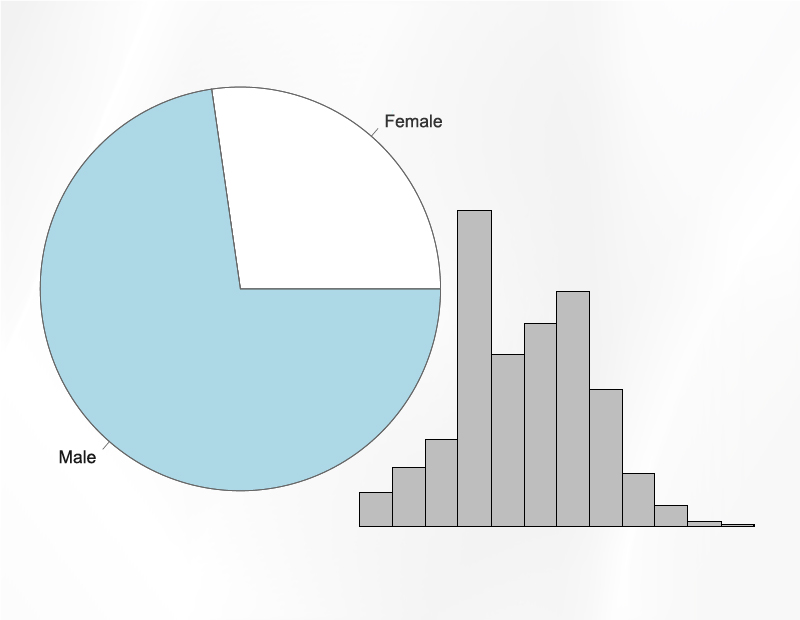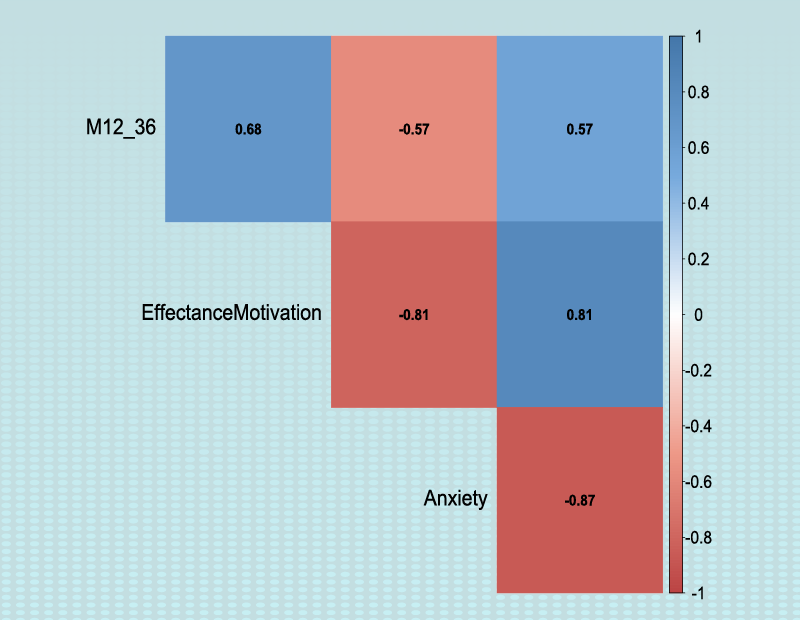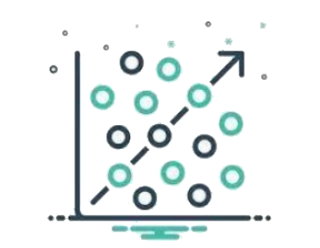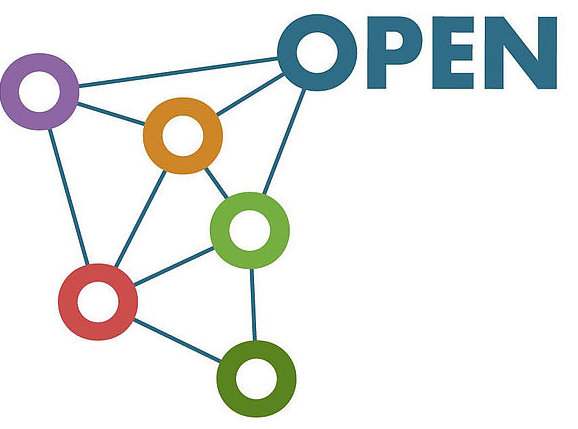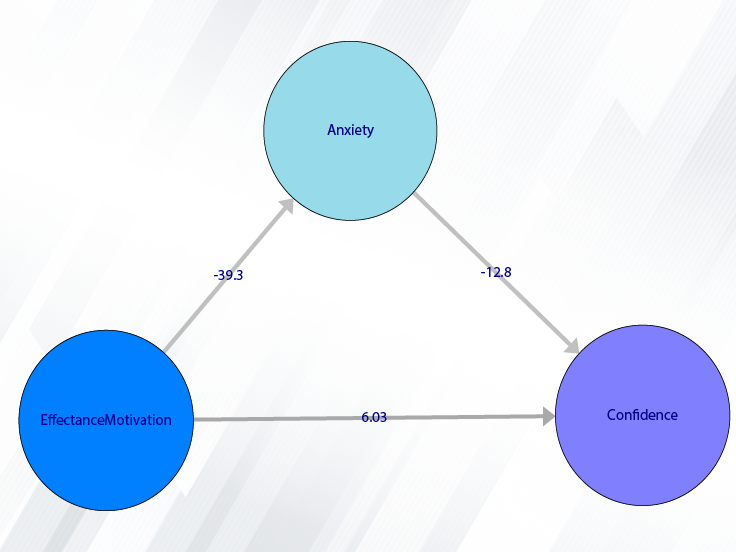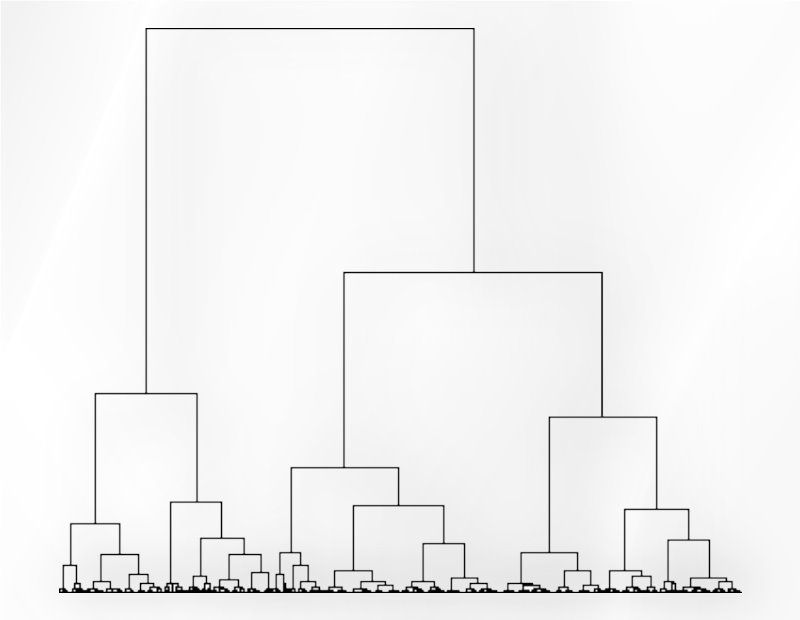Introduction
Structural Equation Model based on Partial Least Squares (SEM-PLS) has been proposed different from the classic
covariance-based LISREL approach.
SEM-PLS is considered a soft modeling approach where no strong assumptions, with respect to the distributions,
the sample size, and the measurement scale are required. SEM-PLS follows the SEM notations and symbols, including
the use of a path diagram to picture the relationships among the LVs(Latent Variables) and between each
MV(Measurement Variable) and the corresponding LV.
An SEM-PLS model is made up of two elements, the outer model (also called the measurement model),
which describes the relationships between the MVs and their respective LVs, and the inner model
(also called the structural model), which describes the relationships between the LVs.
Structural equation models are schematically portrayed using particular configurations of three
geometric symbols circle, square, and single-headed arrow. By convention, circles represent LVs,
squares represent MVs, and single-headed arrows represent the impact of one variable on another. In
building a model of a particular structure under study, researchers use these symbols within the
framework of four basic configurations, each representing an essential component in the analytic process.
These configurations, each accompanied by a brief description, are as Table1.
| Symbol | Definition |
|---|---|
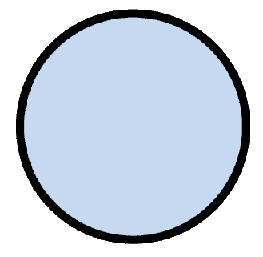
|
Latent Variable |

|
Measurement Variable |

|
The impact of one variable on another |
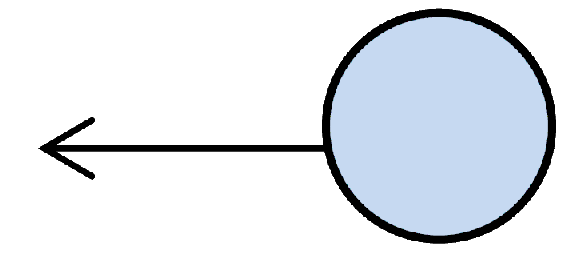
|
Independent Latent Variable |
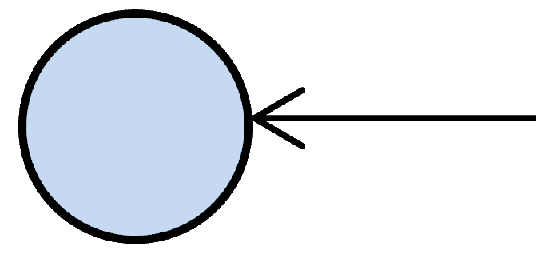
|
Dependent Latent Variable |

|
Mediation Variable |
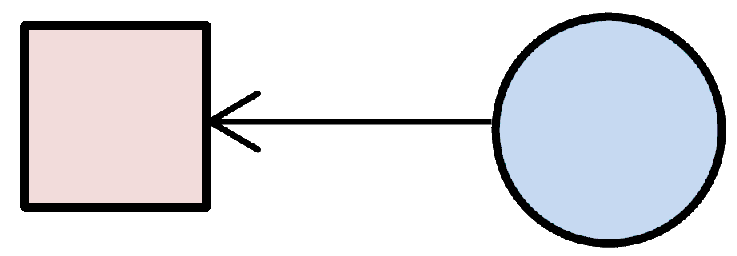
|
Reflective Outer Model |

|
Formative Outer Model |
A. The Outer Model (The Measurement Model)
An LV is an unobservable variable (or construct) indirectly described by a block of observable
variables
 called MVs. There are two ways to relate the MVs to their LVs:
called MVs. There are two ways to relate the MVs to their LVs:
1-The reflective (mode A)
2-The formative (mode B)
A.1. The reflective (mode A)
In the reflective way, each MV reflects the corresponding LV. A block is defined as reflective.
This implies that the relationship between each MV
 and the corresponding LV is modeled as:
and the corresponding LV is modeled as:

Where
 is the simple regression coefficient between the MV and the LV.
is the simple regression coefficient between the MV and the LV.
For example, a reflective way with four MVs can be considered in Figure 1.

Figure 1: Reflective model with four MVs
A.2. The formative (mode B)
In the formative, the LV is supposed to be generated by its own MVs:

Where
 is the simple regression coefficient between the MV and the LV and
is the simple regression coefficient between the MV and the LV and
 is the number of MVs in the block of latent variables.
is the number of MVs in the block of latent variables.
For example, a formative way with four MVs can be considered as Figure 2.

Figure 2: formative way with four MVs
B. The Inner Model (The Structural Model)
The structural model or Inner Model specifies the relationships between the LVs.
If it is supposed to depend on other LVs, an LV is called dependent, and, otherwise, independent.
In the structural model each independent LV is linked to the other LVs by the following multiple
regression model. For Example, for
 ,
,
 ,
,
 ,
,
 and
and
 ,
the path diagram is shown in Figure 3. For this model, the regression relations are:
,
the path diagram is shown in Figure 3. For this model, the regression relations are:




Figure 3: Example of path diagram of the inner model with five LVs.
C. SEM-PLS Algorithm
The SEM-PLS algorithm includes four stages:
1- Approximation of LVs
2- Estimation of the LVs scores
3- Loadings calculation
4- Estimation of the path coefficients
C.1. Approximation of LVs
The first stage of the algorithm consists of four steps
Step1: Initial arbitrary assignment of outer weights;
Step2: Computing the external approximation of the LVs and obtaining the inner weights;
Step3: Computing the internal approximation of the LVs;
Step4: Calculating the new outer weights;
Step5: Repeating step 2 to step 4 until convergence of the outer weights.
C.2. Estimation of the LVs scores
Once the final weights are obtained, the LVs scores are finally calculated as normalized weighted aggregates of the MVs.
C.3. Loadings calculation
The third stage of the algorithm consists of calculating the loadings.
For convenience and simplicity reasons, loadings are preferably calculated as
correlations between a latent variable and its MVs.
Also, Cross Loadings are the loadings of an MV with the rest of the latent variables.
C.4. Estimation of the path coefficients
In the last stage of the SEM-PLS algorithm, the path coefficients are estimated through one of the regression methods among the estimated LV scores, according to the path diagram structure.
D. Sample Size
One of the most fundamental issues in SEM-PLS is that of minimum sample size estimation. We can use one of three methods to determine the sample size:
D.1.The 10-Times Rule Method
The most widely used minimum sample size estimation method in SEM-PLS is the “10-times rule” method. Among the variations of this method, the one usually seen is based on the rule that the sample size should be greater than 10 times the maximum number of inner model links pointing at any latent variable in the model. For example, in the model used in Figure 3, the 10-times rule method leads to the minimum sample size estimation of 30, regardless of the strengths of the path coefficients.
D.2.The Minimum
 Method
Method
This method relies on a table listing minimum required sample sizes based on three elements.
The first element of the minimum
 method is the maximum number of arrows pointing at a latent variable.
The second is the significance level used that we consider being equal to 0.05.
method is the maximum number of arrows pointing at a latent variable.
The second is the significance level used that we consider being equal to 0.05.
The third is the minimum
 in the model. The sample size required for this method is presented in Table 2.
in the model. The sample size required for this method is presented in Table 2.
Table 2: Determination of sample size using Minimum  Method
Method
| Maximum Number of Arrows Pointing at A Construct |
The Minimum

|
|||
| (0,0.1] | (0.1,0.25] | (0.25,0.50] | (0.75,1] | |
| 2 | 110 | 52 | 33 | 26 |
| 3 | 124 | 59 | 38 | 30 |
| 4 | 137 | 65 | 42 | 33 |
| 5 | 147 | 70 | 45 | 36 |
| 6 | 157 | 75 | 48 | 39 |
| 7 | 166 | 80 | 51 | 41 |
| 8 | 174 | 84 | 54 | 44 |
| 9 | 181 | 88 | 57 | 46 |
| More than 9 | 189 | 91 | 59 | 48 |
D.3.The Inverse Square Root Method
This method uses the inverse square root of a sample’s size for standard error estimation.
In this method, the sample size is determined based on the minimum path coefficient as follows:

Where
 s are absolute of path coefficients and [x] gives as output the greatest integer less than x.
s are absolute of path coefficients and [x] gives as output the greatest integer less than x.
E. Validation of model
The evaluation of the inner and outer model results in SEM-PLS builds on a set of evaluation criteria.
Initially, the model assessment focuses on the outer models. When evaluating the outer models, we must
distinguish between reflectively and formatively measured constructs. The criteria for reflective outer
models cannot be universally applied to formative outer models. With formative measures, the first step
is to ensure content validity before collecting the data and estimating the SEM-PLS. If the assessment
of reflective and formative outer models provides evidence of the measures’ quality, the inner model
estimates are evaluated. Hence, after the reliability and validity have been established, the primary
evaluation criteria for the SEM-PLS results are the path coefficients, the coefficients of determination (
 values), GOF, MSE, and …. The assessment of the SEM-PLS outcomes can be extended to more advanced analyses
(e.g., multi-group testing, moderating effects and tests, REBUS, …). Therefore, there are three types of
validation of models which must be done in order:
values), GOF, MSE, and …. The assessment of the SEM-PLS outcomes can be extended to more advanced analyses
(e.g., multi-group testing, moderating effects and tests, REBUS, …). Therefore, there are three types of
validation of models which must be done in order:
1- Validation of outer models
2- Validation of inner models
3- Extra Analysis
E.1.Validation of reflective outer models
The assessment of reflective outer models includes composite reliability to evaluate the internal consistency, individual indicator reliability, and Average Variance Extracted (AVE) to evaluate the convergent validity. In addition, the Fornell-Larcker criterion and cross loadings are used to assess the discriminant validity.
E.1.1. Reliability
In the reflective model, the MVs should be highly correlated, because they are
correlated with the LV of which they are expressed. In other words, the block has to be homogeneous.
There are several tools for checking the homogeneity of a reflective block:
Cronbach’s Alpha:
A block is considered homogeneous if this index is larger than 0.7.

Where
 is the number of MVs in the block of latent variables. Cronbach’s Alpha is sensitive to the number of
items in the scale and generally tends to underestimate the internal consistency and reliability.
is the number of MVs in the block of latent variables. Cronbach’s Alpha is sensitive to the number of
items in the scale and generally tends to underestimate the internal consistency and reliability.
Dillon- Goldstein’s Rho (Composite Reliability): This measures the composite reliability of the block.
A block is considered homogeneous if its composite reliability is larger than 0.7.

Where
 is the correlation between the MV and the LV (Loading) and
is the correlation between the MV and the LV (Loading) and
 is the number of MVs in the block of latent variables.
is the number of MVs in the block of latent variables.
E.1.2. Convergent Validity
A common measure to establish convergent validity on the construct level is the AVE that expresses the degree of
variance of the block explained by
 :
:

Where
 is the correlation between the MV and the LV (Loading) and
is the correlation between the MV and the LV (Loading) and
 is the number of MVs in the block of latent variables.
is the number of MVs in the block of latent variables.
An AVE value of 0.5 or higher indicates that, on average, the construct explains more than half
of the variance of its indicators. Therefore, the AVE is equivalent to the communality of a construct.
In a good outer model, each MV is well summarized by its own LV. So, for each block, a Communality Index
is computed as:

Where
 is the correlation between the MV and the LV(Loading) and
is the correlation between the MV and the LV(Loading) and
 is the number of MVs in the block of latent variables.
is the number of MVs in the block of latent variables.
E.1.3. Discriminant validity
One method for assessing discriminant validity is by examining the cross loadings of the indicators.
Specifically, an indicator’s outer loading on the associated construct should be greater than all of
its loadings on other constructs.
The Fornell-Larcker criterion is another approach for assessing discriminant validity.
It compares the square root of the AVE values with the LV correlations. Specifically,
the square root of each construct’s AVE should be greater than its highest correlation with any other
construct(see Table3).

|

|

|

|
|
|---|---|---|---|---|

|

|
|||

|

|

|
||

|

|

|

|
|

|

|

|

|

|
 is
is
 of
of
 .
.
 is correlation of
is correlation of
 and
and
 .
.
E.2.Validation of formative outer models
We should focus on establishing content validity before empirically evaluating formatively measured constructs.
This makes it necessary to ensure that the formative indicators capture all facets of the construct.
For evaluating formative outer models, we have to test whether the formatively measured construct is highly
correlated with a reflective measure of the same construct. The strength of the path coefficient linking the
two constructs is indicative of the validity of the designated set of formative indicators in tapping
the construct of interest.
For example, Figure 4 shows the Convergent Validity for the two variables q1 and q2. If the analysis exhibits
a lack of convergent validity (
 is low) then the formative indicators of the construct
is low) then the formative indicators of the construct
 do not contribute at a sufficient level to its intended content.
do not contribute at a sufficient level to its intended content.

Figure 4: Convergent Validity Assessment(formative outer model)
This type of analysis is also known as redundancy analysis. Redundancy measures the percent of
the variance of indicators in a dependent block that is predicted from the independent latent
variables associated with the dependent LV. Another definition of redundancy is the amount of
variance in a dependent construct explained by its independent latent variables. The redundancy
index for the j-th MV in k-th dependent LV is:

Where
 is loading a reflective model, and
is loading a reflective model, and
 is the coefficient of determination of LV. Also, redundancy of k-th dependent LV equals to
is the coefficient of determination of LV. Also, redundancy of k-th dependent LV equals to

Where
 is the number of MVs in k-th dependent LV.
is the number of MVs in k-th dependent LV.
E.3. Validation of inner model:
Once we have confirmed that the construct measures are reliable and valid,
the next step addresses the assessment of the inner model results. This involves examining the model’s
predictive capabilities and the relationships between the constructs. The key criteria for assessing the
inner model in SEM-PLS are the significance of the path coefficients, the level of the
 ,
Cohen's
,
Cohen's
 ,
,
 ,
ME, MSE, RMSE, MAE.
,
ME, MSE, RMSE, MAE.
 : This index is the coefficient of determination that how it is calculated depends on the Regression Method.
: This index is the coefficient of determination that how it is calculated depends on the Regression Method.
Cohen's
 : This index is obtained from the following equation:
: This index is obtained from the following equation:

Where
 and
and
 are
are
 value of the dependent LV when a selected independent LV is included in or excluded from the model.
Guidelines for assessing
value of the dependent LV when a selected independent LV is included in or excluded from the model.
Guidelines for assessing
 are proposed
are proposed
Small impact:

Medium impact:

Large impact:

GOF: The GoF(Goodness Of Fit) can be proposed as the geometric mean of the average
communality and the average of
 :
:

Where for
 dependent latent variables,
dependent latent variables,
 and
and
 .
.
ME, MSE, RMSE and MAE: If
 and
and
 the value of dependent latent variable and the dependent variable predicted, respectively:
the value of dependent latent variable and the dependent variable predicted, respectively:




E.4. Extra Analysis
In mediation analysis, the relationship of the independent variable
 to the dependent variable
to the dependent variable
 is influenced by another LV called the Mediator Variable
is influenced by another LV called the Mediator Variable
 (See Figure 5). Therefore, in addition to the direct effect
(See Figure 5). Therefore, in addition to the direct effect
 , we must also consider the indirect effects.
, we must also consider the indirect effects.
Mediator models can be divided into two types, Partial Mediation and Full Mediation.
In Partial Mediation, there is a direct relationship between two variables,
while in Full Mediation, only the mediating variable determines the relationship between these two variables.

Figure 5: Mediator Models
When including the mediator, the indirect effect must be significant.
If the indirect effect is significant, the mediator absorbs some of the direct effect.
The question is how much the mediator variable absorbs. To answer this question, the size
of the indirect effect in relation equals to:
 Consequently, tests must answer the following questions, is the indirect effect via the mediator
variable significant after this variable has been included in the model?
Consequently, tests must answer the following questions, is the indirect effect via the mediator
variable significant after this variable has been included in the model?
To answer this question, the following mediation tests are provided:
E.4.1.1. Sobel Test, Aroian Test, and Goodman Test
Sobel Test, Aroin Test, and Goodman Test use the magnitude of the indirect effect compared
to its estimated standard error of measurement to derive a
 statistic
statistic



Where
 and
and
 are variance of
are variance of
 and
and
 respectively.
respectively.
 ,
,
 and
and
 statistics can then be compared to the normal distribution to determine its significance.
statistics can then be compared to the normal distribution to determine its significance.
However, these tests rely on distributional assumptions, which usually do not hold.
Furthermore, these tests require unstandardized path coefficients as the input for the test
statistics and lack statistical power, especially when applied to small sample sizes.
The permutation test can be suggested to solve this problem.
E.4.1.2. Permutation test
For B replication, the permutation test uses the following algorithm:
1- Model runs to obtain
 and
and
 an estimate for the real data and
an estimate for the real data and
 is calculated.
is calculated.
2- For each regression model, the dependent latent values are permuted randomly
3- Model runs to obtain
 and
and
 for the permuted data and
for the permuted data and
 is calculated.
is calculated.
4- Steps 2-3 are repeated number B of times.
5- Suppose

Where
 value of
value of
 in jth replication and
in jth replication and
 function means if
function means if
 this function is equal to 1 and otherwise 0. The P-value of the permutation test is obtained from
the following relation:
this function is equal to 1 and otherwise 0. The P-value of the permutation test is obtained from
the following relation:

E.4.2. Moderator Analysis
Moderating effects are evoked by variables whose variation influences the strength or the direction
of a relationship between independent and dependent variables (See Figure 6)

Figure 6: Model with a moderating effect
Basically, there are two main methods to study moderating effects depending on the nature
of the moderator variable:
E.4.2.1. Moderator (Interaction) Constructs
This approach applies when the moderator variable is an LV; MVs of a latent
moderator variable is observed and quantitative. Under this approach,
moderator variables are considered in the inner model. In this method, the interaction variable
Basically, there are two main methods to study moderating effects depending on the nature
of the moderator variable:
 is made by multiplying
is made by multiplying
 and
and
 i.e.
i.e.
 . For example, if q1, q2 are MVs of
. For example, if q1, q2 are MVs of
 , q3, q4 are MVs of
, q3, q4 are MVs of
 , and q5, q6 are MVs of
, and q5, q6 are MVs of
 then the interactive model is shown in Figure 7. To calculate the interaction latent variable
then the interactive model is shown in Figure 7. To calculate the interaction latent variable
 first MVs q1×q3, q1×q4, q2×q3, q2×q4 are calculated and then
first MVs q1×q3, q1×q4, q2×q3, q2×q4 are calculated and then
 is created based on them.
is created based on them.

Figure 7: Model with a interaction variable
E.4.2.2. Group Analysis
This approach applies when the moderator is an observed MV, and it is a qualitative variable or can be categorized. In this case, the sample is split into two or more groups relating to the codes of the qualitative variable, and the path coefficient of the moderated relationship is estimated for each of the sub-samples. For Group Comparisons, Two types of tests are suggested:
E.4.2.2.1. t test
Suppose we have two groups
 and
and
 with path coefficients
with path coefficients
 and
and
 , sample sizes of
, sample sizes of
 and
and
 , and Standard Errors of
, and Standard Errors of
 and
and
 , respectively. The formula that we use for the t-test statistic is:
, respectively. The formula that we use for the t-test statistic is:

Where
 is the estimator of the pooled standard deviation and is obtained as follows:
is the estimator of the pooled standard deviation and is obtained as follows:

Therefore, the P-value of this test is obtained from the following equation:

Where
 is the cumulative function of standard normal distribution.
is the cumulative function of standard normal distribution.
However, these tests rely on distributional assumptions, which usually do not hold. In addition,
this test can not test the difference between groups in
 , GOF, Cohen's
, GOF, Cohen's
 , ME, MSE, RMSE and MAE indices. To solve this problem, the permutation test can be suggested.
, ME, MSE, RMSE and MAE indices. To solve this problem, the permutation test can be suggested.
E.4.2.2.2. Permutation test
Suppose
 is one of the
is one of the
 (path coefficient),
(path coefficient),
 (loading),
(loading),
 , GOF, Cohen's
, GOF, Cohen's
 , ME, MSE, RMSE and MAE indices. we have two groups
, ME, MSE, RMSE and MAE indices. we have two groups
 and
and
 with sample sizes of
with sample sizes of
 and
and
 , and Standard Errors of
, and Standard Errors of
 and
and
 and index of
and index of
 and
and
 . For B replication, the permutation test uses the following algorithm:
. For B replication, the permutation test uses the following algorithm:
1- Model runs to obtain
 and
and
 for the real data and
for the real data and
 is calculated.
is calculated.
2- For each regression model, the dependent latent values are permuted randomly.
3- Model runs to obtain
 and
and
 for the permuted data and
for the permuted data and
 is calculated.
is calculated.
4- Steps 2-3 are repeated number B of times.
5- Suppose

Where

value of
 in jth replication and
in jth replication and
 function means if
function means if
 this function is equal to 1 and otherwise 0.
The P-value of the permutation test is obtained from the
following relation:
this function is equal to 1 and otherwise 0.
The P-value of the permutation test is obtained from the
following relation:

E.4.3. REBUS (Response Based Unit Segmentation)
Many datasets are far from being a homogenous mass of data. More often than not, you will find subsets
of observations with a particular behavior; perhaps there is a subset that shows different patterns
in the distribution of the variables, or maybe there are observations that could be grouped together
and analyzed separately. It might well be the case that one single model is not the best model for
your entire dataset, and you might need to estimate different path models for different groups of observations.
One of the traditional examples is when we have demographic information like gender, and we apply
a group analysis between females and males. But what about those situations when we don’t have
categorical variables to play with for multi-group comparisons? In these circumstances we could
still apply a SEM-PLS analysis but we probably will be wondering “What if there’s something else?
What if there’s something hidden in the data?
In this situation, we can use the REBUS method. REBUS is a technique inspired by cluster analysis techniques,
and it applies clustering principles to obtain the solution. But don’t get confused. REBUS is not equivalent
to cluster analysis. Although you could apply your favorite type of cluster analysis method to detect
classes in your data, this is not what we are talking about.
REBUS uses the following algorithm:
1- Estimation of the Path Model.
2- Computation of the residuals of the model.
3- Perform a hierarchical clustering on the residuals computed in step 2.
4- Choose the number of classes K according to the dendrogram obtained in step 3.
5- Assignment of the observations to each group according to the cluster analysis results.
6- Estimation of the K local models.
7- K Groups are compared with one of the methods of Group Analysis (t test or Permutation test).










